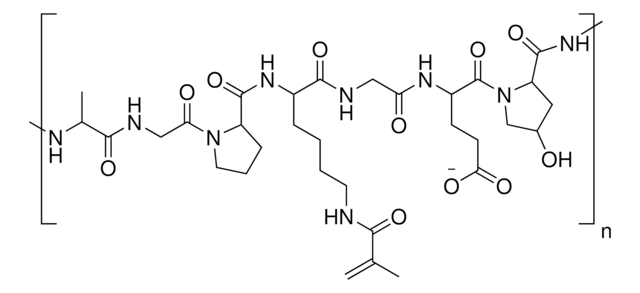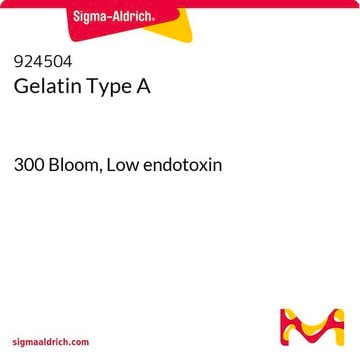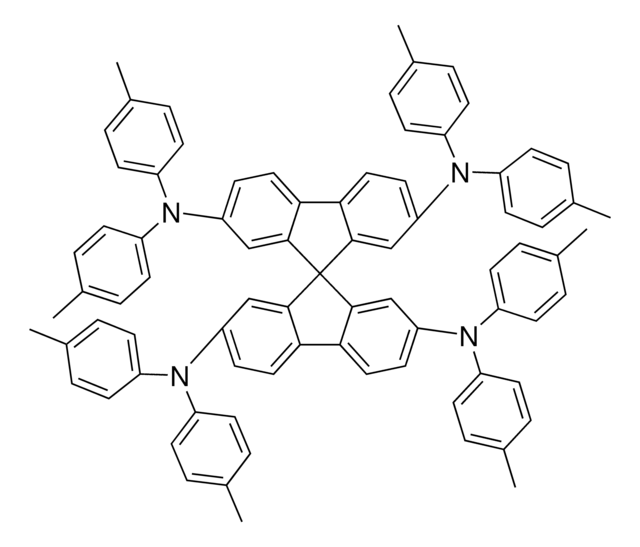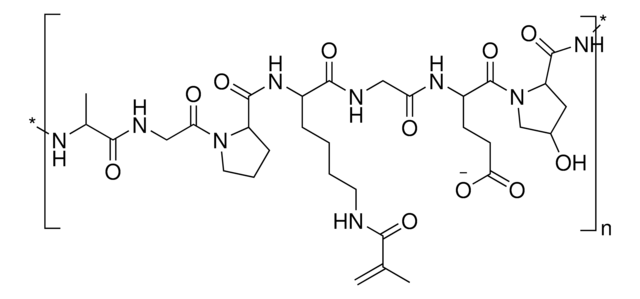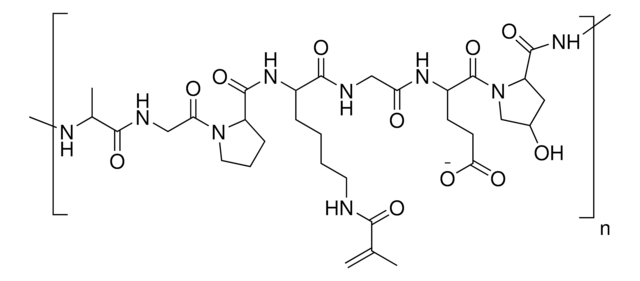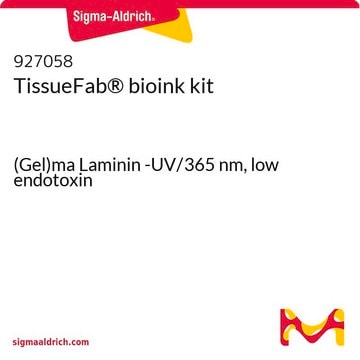推荐产品
品質等級
描述
Application: 3D bioprinting, tissue engineering
形狀
powder or chunks (or fibers)
顏色
white to light brown
儲存溫度
−20°C
一般說明
Gelatin methacryloyl, also known as gelatin methacrylate or GelMA, is a methacrylate-functionalized gelatin biomaterial. The gelatin amine groups are chemically modified with methacrylate groups, which when combined with light and a photoinitiator, can be be photopolymerized to form a hydrogel with a three-dimension network that closely mimices the native extracellular matrix (ECM). GelMA is often used as a scaffold for cell culture and tissue regeneration, as it provides a supportive environment for cell attachment, proliferation, and differentation. Its properties, such as mechanical strength, degradation rate, and gelation behavior, can be adjusted by modifying the degree of methacrylation and crosslinking density.
Many GelMAs currently available have a high degree of variation and inconsistency. To address this, the TissueFab® Discrete GelMAs have been developed to achieve a specific degree of methacrylation with low batch to batch variability.
Many GelMAs currently available have a high degree of variation and inconsistency. To address this, the TissueFab® Discrete GelMAs have been developed to achieve a specific degree of methacrylation with low batch to batch variability.
應用
*Tissue engineering - including bone tissue, cartilage tissue, epidermal tissue, and cardiac tissue
*Regenerative medicine - including injectable tissue constructs and endothelial cell morphogenesis
*Drug and cell delivery - in the form of microspheres and hydrogels
*Surface coatings - of medical devices and implants in order to improve biocompatibility and release therapuetic cargos
*Regenerative medicine - including injectable tissue constructs and endothelial cell morphogenesis
*Drug and cell delivery - in the form of microspheres and hydrogels
*Surface coatings - of medical devices and implants in order to improve biocompatibility and release therapuetic cargos
特點和優勢
*Specific degree of methacrylation - a narrow peak of methacrylation allows for better reproducibility, low batch to batch variability, for improved consistency of gel properties and cell behavior.
*Biocompatibility - GelMA contains RGD sequences, found in collagen and other natural ECM proteins, which promote cell adhesion, proliferation, differentiation, and maturation of a variety of cell types.
*Biodegradability - GelMA contains matrix metalloproteinase (MMP) degradable sites that can be recognized and enzymatically degraded by cells. This allows the encapsulated cells to degrade and remodel the GelMA matrix, and repopulate with their own cells and tissues, a major goal for tissue engineering and regenerative medicine.
*Tunability - The TissueFab(R) Discrete GelMAs are available in a variety of degrees of substitution which ultimately impact the hydrogel stiffness and mechanical properties and can be used to recapitulate and accomodate different native tissues.
*Bioprintability - The TissueFab(R) Discrete GelMAs are widely used in the field of 3D bioprinting due to their unique gelation properties and the ability to print via extrusion and other methods to create intricate cell-encapsulated 3D structures with high cell viability.
*Biocompatibility - GelMA contains RGD sequences, found in collagen and other natural ECM proteins, which promote cell adhesion, proliferation, differentiation, and maturation of a variety of cell types.
*Biodegradability - GelMA contains matrix metalloproteinase (MMP) degradable sites that can be recognized and enzymatically degraded by cells. This allows the encapsulated cells to degrade and remodel the GelMA matrix, and repopulate with their own cells and tissues, a major goal for tissue engineering and regenerative medicine.
*Tunability - The TissueFab(R) Discrete GelMAs are available in a variety of degrees of substitution which ultimately impact the hydrogel stiffness and mechanical properties and can be used to recapitulate and accomodate different native tissues.
*Bioprintability - The TissueFab(R) Discrete GelMAs are widely used in the field of 3D bioprinting due to their unique gelation properties and the ability to print via extrusion and other methods to create intricate cell-encapsulated 3D structures with high cell viability.
法律資訊
TISSUEFAB is a registered trademark of Merck KGaA, Darmstadt, Germany
相關產品
产品编号
说明
价格
儲存類別代碼
11 - Combustible Solids
水污染物質分類(WGK)
WGK 3
閃點(°F)
Not applicable
閃點(°C)
Not applicable
Mineralized gelatin methacrylate-based matrices induce osteogenic differentiation of human induced pluripotent stem cells.
Kang H, Shih YR, Hwang Y, et al.
Acta Biomaterialia, 10(12), 4961-4970 (2014)
Covalent attachment of a three-dimensionally printed thermoplast to a gelatin hydrogel for mechanically enhanced cartilage constructs.
Boere KWM, et al.
Acta Biomaterialia, 10(6), 2602-2611 (2014)
Direct-write bioprinting of cell-laden methacrylated gelatin hydrogels.
Bertassoni LE, Cardoso JC, Manoharan V, et al.
Biofabrication, 6(2), 024105-024105 (2014)
The 3D printing of gelatin methacrylamide cell-laden tissue-engineered constructs with high cell viability.
Billiet T, Gevaert E, De Schryver T, et al.
Biomaterials, 35(1), 49-62 (2014)
Facile one-step micropatterning using photodegradable methacrylated gelatin hydrogels for improved cardiomyocyte organization and alignment.
Tsang K, et al.
Advances in Functional Materials, 25(6), 977-986 (2015)
我们的科学家团队拥有各种研究领域经验,包括生命科学、材料科学、化学合成、色谱、分析及许多其他领域.
联系技术服务部门